The bend options are determined for the current sheet metal part by the active Sheet Metal rule. This rule is set for the part using the Sheet Metal Defaults command. The bend options can be overridden for the feature being created by changing the bend shape, transition, and parameter values on this dialog box tab.
| Access: | |
|---|---|
|
While creating a Sheet Metal Bend, Contour Flange, Face, Flange, Fold, or Hem, click the Bend tab on the feature creation dialog box. Note: Not all options described are available or valid for each feature that shares this tab.
|
|
|
Relief Shape |
|
|
Use this option to accept the Default relief shape specified in the Sheet Metal Style or to define explicitly the shape as one of three supported reliefs. |
|
|
|
Straight A bend relief shape defined by square corners. It is common in manual shop situations and often produced by a saw kerf. In the following illustration, "A" indicates the bend relief width, "B" indicates the bend relief depth beyond the deformation zone, and "C" represents the size of the material remnant left following the creation of the bend with relief. Each of these parameters defaults to the value defined in the Sheet Metal Style, but can be individually edited on a per-feature basis by using this option. |
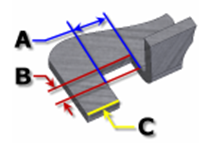 |
|
|
|
Tear An acceptable bend relief resulting from material failure. It is common when tight bends are required and with certain materials. In the following illustration, "C" represents the size of the material remnant left following the creation of the bend with relief. This parameter defaults to the value defined in the Sheet Metal Style, but can be individually edited on a per-feature basis by using this option. |
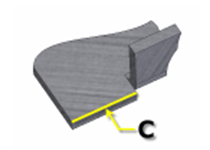 |
|
|
|
Round A bend relief shape defined by a cut ending with a semicircle. It is often produced using laser cutting technology. In the illustration following, "A" indicates the bend relief width (diameter), "B" indicates the bend relief depth beyond the deformation zone to the tangent point of the diameter, and "C" represents the size of the material remnant left following the creation of the bend with relief. Each of these parameters defaults to the value defined in the Sheet Metal Style but can be individually edited on a per-feature basis by using this option. |
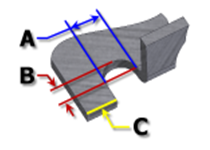 |
|
|
Relief Width |
Value field which defines the width of the bend relief. Defaults to the parameter BendReliefWidth as defined in Sheet Metal Styles. Identified as "A" in the dialog box illustration. |
|
Relief Depth |
Value field which defines the depth of the bend relief. Defaults to the parameter BendReliefDepth as defined in Sheet Metal Styles. Identified as "B" in the dialog box illustration. |
|
Minimum Remnant |
Value field which defines an acceptable size for the minimum stock allowed to remain along side of a bend relief cut. (Any remainder smaller is eliminated from the model.) Defaults to the parameter MinimumRemnant, as defined in Sheet Metal Styles. |
Bend Transition
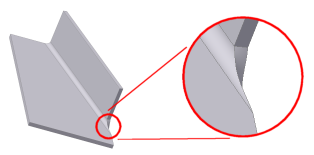
Use the Bend Transition option to define one of five geometry conditions that show in the flat pattern of the bend. The folded model either shows the transition type of None (for all transition types except Trim) or the type Trim if that is the selected type.
|
|
None - Depending on the geometry, results in a spline between the edges of the two faces meeting at the selected bend. In the illustration below, the portion of the flat pattern showing this transition type is illustrated for the folded model shown previously. |
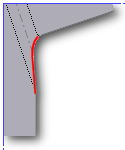 |
|
|
|
Intersection - Results in a straight line from the edge of the bend zone which intersects the edge of the bent feature. In the illustration below, the portion of the flat pattern showing this transition type is illustrated for the folded model shown previously. |
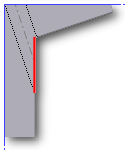 |
|
|
|
Straight Line - Results in a straight line from one edge of the bend zone to the other. In the following illustration, the portion of the flat pattern showing this transition type is illustrated for the folded model shown previously. |
 |
|
|
|
Arc - Requires entry of an arc radius value and results in an arc of that size tangent to the edge of the bent feature and what is a straight transition. In the following illustration, the portion of the flat pattern showing this transition type is illustrated for the folded model shown previously. |
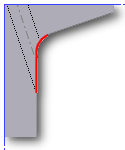 |
|
|
|
Trim to Bend - This type of transition is displayed in the folded model and results in a cut to the bend zone perpendicular to the bent feature. In the following illustration (left), the portion of the flat pattern showing this transition type is illustrated for the folded model shown on the right. |
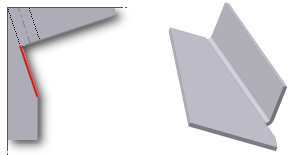 |